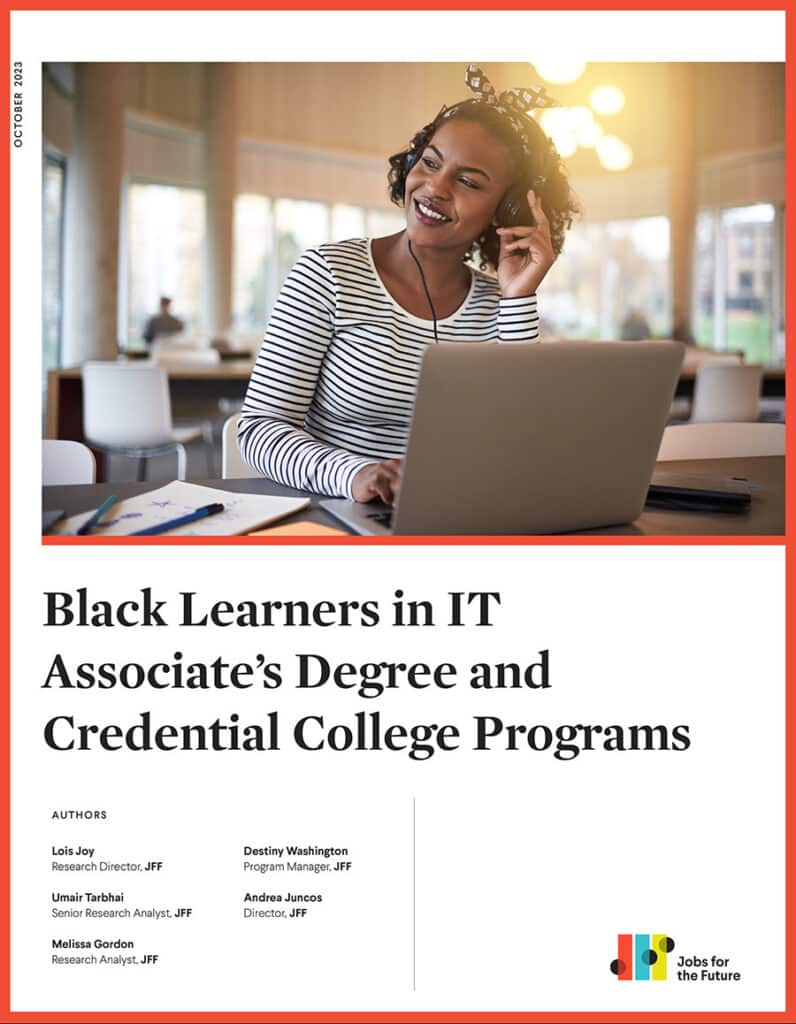Information technology (IT) jobs are in demand and pay well. But Black Americans comprise only 8% of the tech workforce.
Why? Structural barriers make it difficult for Black learners and workers to access and thrive in IT training programs, according to a new Jobs for the Future (JFF) report, which highlights data on Black learners in two-year and credential IT programs, examines the barriers facing Black learners and includes insight from administrators and faculty at community colleges.
The data
JFF found that 1,000 postsecondary institutions offer IT training programs. Only 40% of those IT programs had at least 10 Black learners enrolled in 2017 to 2021.
Overall, for each year of JFF’s study, there were about 180,000 total students enrolled in IT programs across the country. Between 24,000 and 25,000 were Black learners.
Looking at gender, on average, only about 35% of the 1,000 colleges had at least 10 Black male learners enrolled in their IT program per year. That dropped to 15% for Black women.
JFF also examined six-year completion rates. Researchers looked at schools that had at least 10 first-time Black learners enrolling in their IT program in fall 2015, of which 108 met this threshold. Across the schools in that sample, the average IT completion rate for Black learners was 12.9%, equaling about three Black learners per college.
Further, Black women are much less likely than Black men to earn technology degrees. In 2020, Black women earned 74% of all associate degrees held by Black learners but only 26% of computer and information sciences degrees, the report says, citing U.S. Education Department data.
Insight from colleges
To better understand why Black learners weren’t enrolling or persisting in IT programs, JFF held focus groups with administrators and faculty from five community colleges – four in the South (where overall Black student enrollment is higher) and one in the Midwest. These colleges met JFF’s top thresholds for enrollment, retention and completion.
When it came to student recruitment and supports, the colleges didn’t explicitly account for students’ racial or gender identity. Instead, the colleges mostly took a “race-neutral” approach, prioritizing “the development of policies, programs, and strategies that met the many and varied needs of all students without specific regard to race, ethnicity, or gender,” the report says.
The colleges all noted the importance of dual enrollment and career navigation tools in getting students interested in IT early, and the importance of internships, mentorships and engaged faculty in retaining students. They also discussed wraparound services as a primary strategy for student retention. But, again, those supports are in place for all students.
A participating faculty member from a community college in the South said, “And so far as what I do or provide as it relates to our Black students, I don’t do anything specifically for our Black students. What I do specifically is try to make them the best that they can actually be regardless.”
The exception to the race-neutral approach taken by most colleges was one college that is using disaggregated institutional and survey data to identify and provide specific supports for Black learners. That college also has taken a proactive approach to hiring Black faculty and has launched a Black community-wide support group.
Acknowledging barriers
That doesn’t mean that the other colleges aren’t aware of the barriers Black learners face, though.
For one college in the South — designated a historically Black college or university (HBCU) – faculty said, though Black student-focused policies and strategies were needed, practicing inclusion for all learners means they may face less “backlash” than if they took a Black student-focused approach.
Recruiting Black men is a particular challenge for the colleges. Some colleges noted that outreach to local majority-Black high schools was an important strategy for recruitment for the college and for IT programs, but recruitment efforts didn’t necessarily address the needs of Black learners.

Recruiting Black women into college was less of a concern. And recruiting them into IT programs also didn’t seem to be a priority, though the Midwest college noted it has revamped program recruitment materials to be more gender inclusive.
Despite the race-neutral approach, all focus-group colleges had implemented targeted, one-off supports for Black learners, such as laptop loaner programs, Black male mentoring programs and special articulation agreements and support for Black STEM learners who were transferring to a four-year institution.
JFF’s report notes, however, that “a structural approach to Black educational equity is likely more effective than the one-off program or strategy approach.”
“By not explicitly including Black men’s and women’s needs and perspectives into policies, initiatives, and strategies, postsecondary systems and institutions are less likely to disrupt systems that prevent Black learner success or to transform them into systems that can foster economic opportunity,” the report says.

